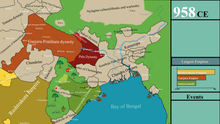The Bhanja dynasty is a dynasty that originated in the northern and central regions of modern Odisha (in the Khiching region of Utkala and Khinjali mandalas) before the Gupta Empire became an imperial power. The dynasty, of ancient local Kshatriya lineage[1][2] as documented by Hermann Kulke, succeeded the Vindhyatabi branch of the Nagas of Padmavati, who ruled from the Keonjhar district of Odisha and included Satrubhanja of the Asanpat inscription.[3][4] The Bhanj later became feudatories of the Bhauma-Kara dynasty.[5]

The successor branches of the Bhanja rulers became local feudatories to the united realms of the Eastern Ganga dynasty, the Gajapati Kingdom, and ruling dynasties of the princely states and zamindaries of the region with the advent of British rule. Prominent branches include the princely states of Mayurbhanj State and Keonjhar State.
- ^ Kulke, Hermann. Kshatriyaization and social change: A Study in Orissa setting. p. 404. OCLC 1236863278.
- ^ Kulke, Hermann (1993). Kings and Cults: State Formation and Legitimation in India and Southeast Asia. Manohar Publishers & Distributors. p. 116. ISBN 9788173040375.
the Bhanja families of Mayurbhanj, Keonjhar, Baudh, Ghumsur and Kanika are linked with the ancient Bhanjas who had ruled in several branches over parts of northern Orissa, the central Mahanadi valley and southern Orissa since the late centuries of the first millennium AD.
- ^ Inscriptions of Orissa: Circa 5th-8th centuries A.D, Volume 1. Delhi: Motila Banarsidass Publishers Private Limited. 1997. pp. 171–172. ISBN 81-208-1077-5.
- ^ "ORIGIN, GENEALOGY AND CHRONOLOGY OF THE BHANJAS". www.shodhganga.inflibnet.ac.in. pp. 74, 75. hdl:10603/191656. Retrieved 7 May 2018.
- ^ Agrawal, Ashvin (1989). Rise And Fall Of The Imperial Guptas. Motilal Banarsidass. p. 60. ISBN 9788120805927. Retrieved 2 March 2021.